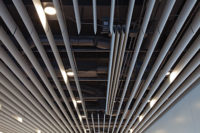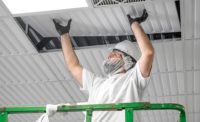Passing through the entry of the Burj Khalifa tower in Dubai, U.A.E.—currently the world’s tallest building—one encounters a complex, double-curved wood ceiling floating overhead that approaches the complexity of the tower that hosts it. The ceiling was detailed, built and shipped to the Middle East, and installed in an aggressive 11-month timeframe by an integrated project team comprised of Imperial Woodworking, the design team at Skidmore Owings & Merril, Rick Herskovitz at ICON Integrated Construction, and the New York office of Gehry Technologies.
Early on in the process, the team took a unitized panel approach to the ceiling. Panels were fabricated in Imperial’s shop in Chicago and then transported in groups, sequencing the fabrication and the installation to meet the schedule. While constructing and finishing the panels in the shop helped out with control and quality, the design needed to be pre-coordinated and fully detailed before arriving at the building site.
This led to the adoption of a fully-detailed parametric fabrication model for use by everyone on the team, from the designers, to the fabricators, to the installers working in the field. Built on GT’s Digital Project platform and hosted in a datacenter with a file versioning database for project collaboration, multiple parties in different geographic locations were able to access and work on the same model data concurrently. Likewise, the complete design history of the project was accessible through the versioning system.
TARGET POINTS
Existing conditions played a huge role in the coordination effort. Target points for key building interfaces (slab edges, top of steel points, etc.) were digitally surveyed and entered into the model as geometry. Seeing the designed position of the slab edges and being able to compare them against actual physical coordinate points gave certainty in the detailing process.
The modeling process was designed from the beginning to respond to change. Using the parametric geometry engine of DP, the surface and panel joint centerline geometry was rationalized into fundamental shapes, allowing for more repetition in the panels without sacrificing the complexity of the overall design. The parametric geometry system also afforded the ability to go back and make fundamental changes to the shape and size of the driving surface without having to remodel all the downstream detail components.
For example, weeks before the panels were shipped, the steel columns supporting the boat-shaped piece of the ceiling were surveyed and found to be inches off from the design drawings and models. Instead of field cutting the end panels or taking up the difference in a single panel resulting in an aesthetic issue, every single part in the entire boat panel assembly was updated prior to fabrication to accommodate the true as-built steel. This saved weeks of lost time in fabrication and shipping for new panels, as well as avoided costly change orders.
TEMPLATES
Building on the wireframe and surface driver geometry, a set of digital templates were used for each of the panels to generate all the components in 3-D (the outer plank surfaces, two layers of bending plywood, and an interconnecting “waffle frame” system), along with any associated CAM data (2-D cut profiles for the components, jigs, registration and assembly drawings).
These templates also have the ability to change their internal configuration based on a change to the input geometry (in this case, the design surface, the joint centerline curves and some curves that defined the panel boundary). As a result, if the shape of the design surface or the spacing of the joints is altered (as in the update of the boat geometry) all the linked 3-D solid geometry was updated to reflect the change. This created an environment for precise 3-D detailing of the components—with enough slack to allow the detailer to slide frames around or try different frame configurations—all without having to go back and remodel every panel.
Although these systems represent an investment in time and effort in the early stages of the panel detailing, they quickly pay off when responding to the changing nature of the design as the project progressed. Similarly, multiple people could be simultaneously working in the same model. For instance, a team on the ground in Dubai worked to coordinate installation and MEP routing at the same time the panels were being detailed and mocked-up in the shop. All this digital information was organized into the central project Master Model, with multiple participants committing changes from different locations. The results could continuously be cross-checked in review meetings, and information from the model could be used to feed information directly to the fabrication shop floor (in the case of direct-to-fabrication production of the panel parts), as well as to the job site (where the model was used to check dimensions and aid installation).
DIGITAL MODELING
Another interesting use of the digital model data was the production of CNC cut 2-D templates. These were used to help communication across the various trades on-site and ensure constructability. Instead of relying solely on the contractor to coordinate efforts in a chaotic construction environment, 1:1 templates were cut from model profiles and used to check the fit of certain components at spots that were considered tight. Alternately certain lines were spray painted directly onto the slab to communicate work zones and key interfaces between the various trades. Everyone on site instantly knew where the new edge of the ceiling was because that line was marked directly on site and pre-coordinated to work. This was especially useful on a construction site of this scale and complexity.
Though not a simple process to employ, the use of a coordinated fabrication model in a parametric environment enabled the rapid and accurate fabrication of the Burj Khalifa office lobby ceiling. From the design of the surface, to the deployment of content-rich templates for fabrication data, to installation and coordination, the model-centric database approach created a ceiling and a process worth admiring. W&C












Report Abusive Comment